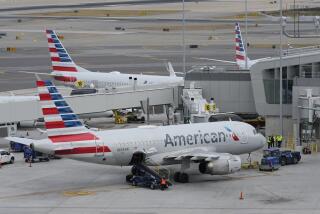Ka-ching! ATMs rake in charges overseas
- Share via
If you vacation outside the country this summer, you might come home to find your checking account smaller than expected.
Who raided it? Don’t blame the kids.
For the record:
12:00 a.m. June 17, 2007 For The Record
Los Angeles Times Tuesday June 12, 2007 Home Edition Main News Part A Page 2 National Desk 1 inches; 36 words Type of Material: Correction
ATM fees: An article in Business on Sunday about fees charged by U.S. banks when their customers use foreign ATMs identified Lisa Westermann as a spokeswoman for City National Bank. Westermann works for Wells Fargo Bank.
For The Record
Los Angeles Times Sunday June 17, 2007 Home Edition Main News Part A Page 2 National Desk 1 inches; 38 words Type of Material: Correction
ATM fees: An article in the June 10 Business section, about fees charged by U.S. banks when their customers use foreign ATMs, identified Lisa Westermann as a spokeswoman for City National Bank. Westermann works for Wells Fargo Bank.
It might have been your bank.
The fees charged by banks as well as other financial institutions to use foreign automated teller machines can deplete cash faster than lunch in London. Some U.S. banks charge as much as $5, plus a percentage, every time a debit card they issued is used at a foreign ATM.
Not that you would know it at the time. Unlike in the U.S., where you get an on-screen warning if additional fees are to be collected for a machine withdrawal, these charges are often invisible until you get your bank statement back home.
Even highly seasoned travelers can be caught off guard.
“I used to always use my ATM when I traveled because I thought it gave me the best exchange rate,” said Harlan Levinson, a Los Angeles accountant who often travels outside the country.
During an October trip to Vietnam, he used his debit card issued by City National Bank. When he got home, he noticed for the first time a 2.8% charge on every ATM withdrawal.
“I was surprised,” he said. “It’s not much money. Even if you take out $2,000, it’s only about $60.
“But even if it’s only $10 a pop for everyone traveling, if the bank gets it 100,000 times, that’s good money for them.”
Levinson has since received a debit card from a bank that has better terms, but he’s resigned to paying a fee for each withdrawal.
“Every way that the banks can charge more money,” he said, “they do it.”
A sampling of banks in the Los Angeles area found that each had its own fee structure for foreign ATM withdrawals.
Bank of America charges $5, plus 1% of the withdrawal.
City National Bank charges $1.50, plus 3%.
Wells Fargo charges a flat fee of $5.
Washington Mutual charges 1%, with no flat fees.
Some of the rates come with asterisks, for better or worse. For example, Bank of America has an association with some foreign banks that allow its customers to use their ATMs sans fees.
On the other hand, Washington Mutual’s percentage-only charge is available exclusively to its customers who signed up for its “free” checking program after March 2006. Other “free” checking account holders pay an additional $2 per withdrawal.
(Tip: If you have one of those older checking accounts at Washington Mutual, visit a branch to get the new “free” program. The bank will not switch it over the phone.)
All things being equal, Washington Mutual has the best deal of these banks for travelers making a withdrawal of up to $499. Above that, Wells Fargo debit cardholders have the advantage.
Anything over a 1% charge could be a bonus to a bank, at least in regard to currency exchange costs on Visa debit cards. That’s because 1% is the assessment charged the banks by Visa to provide exchange services.
Bank of America spokeswoman Betty Riess said that was reflected in the 1% charged for foreign ATM transactions.
But what about the additional $5?
“We do not discuss the costs involved in doing business,” Riess said.
City National Bank spokeswoman Lisa Westermann said that international transactions “have higher processing costs and greater risk for the bank,” but she did not elaborate.
Gail Hillebrand of the nonprofit Consumers Union, publisher of Consumer Reports magazine, said that foreign ATM fees had crept up on consumers over the last few years.
“We used to tell people that it was a good idea to get cash from an ATM and use it for purchases instead of a credit card,” she said.
This was to avoid the fees that credit card companies were assessing for foreign purchases. In most cases, using a U.S.-issued Visa or MasterCard now costs an extra 3% outside of the country.
“But then the debit cards “started adding the fees too,” Hillebrand said.
The fees are especially troublesome because the debit card has become a near-irreplaceable standard for travelers.
“People are trying to reduce the amount of cash they carry around to reduce the theft risk,” she said. “We have all been induced to use plastic.
“But now we’re getting hit for using the plastic in the way it was designed to be used.”
Although the banks surveyed sing the praises of their debit card programs on their websites, none of them included the amounts of the foreign withdrawal fee charges.
“It is sent to people,” Washington Mutual spokeswoman Diana McSweeney said.
So, all of you out there who read the inserts that come with your bank mailings will not be surprised.
At least the charges are broken out on the statements. That’s how Levinson found out he had been assessed the fees.
In this way, the debit card issuers avoid the class action suits alleging that credit card companies and banks rolled the fees into currency-converted charges that showed up on bills.
In 2006, MasterCard, Visa and several banks agreed to pay customers $336 million in lawsuit settlements in which they did not admit to any wrongdoing.
Last week, Bank of America announced a new program to better explain its policies in regard to fees and other matters. A brochure, “Our Account Fees Explained,” will be distributed online and in branches next month.
Consumers Union made public a letter it wrote in response, saying the bank should “reduce fees and eliminate fee-triggering practices, not just simplify its disclosures.”
When it comes to foreign ATM fees, most people probably aren’t in a good frame of mind to fight them, Hillebrand said.
“When you get back from vacation,” she said, “that’s when you’re putting the kids back in school. You’re getting back to work.
“It’s not a good time to address a consumer issue.”
--
(BEGIN TEXT OF INFOBOX)
-
Avoiding ATM fee shock
--
While traveling outside the country, it’s nearly impossible to avoid being hit with ATM withdrawal fees. But you can minimize the damage.
--
Check with your bank before traveling to find out exactly what fees are charged. You’ll probably have to phone -- bank websites seldom list the fees.
--
If you do a lot of traveling, you might want to shop around to get an account with a bank that offers a better deal. The fees vary greatly from bank to bank.
--
Ask your bank whether it has a relationship with banks in the countries you will be visiting. For example, Bank of America debit card holders can use the ATMs at Barclays Bank in Britain without paying fees.
--
If your bank imposes a flat fee for each ATM visit, limit usage by always withdrawing as much cash as you feel comfortable carrying around with you.
--
Source: Times research
More to Read
Inside the business of entertainment
The Wide Shot brings you news, analysis and insights on everything from streaming wars to production — and what it all means for the future.
You may occasionally receive promotional content from the Los Angeles Times.











